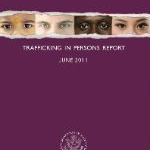A BLOG POST BY STEPHENIE FOSTER Last week, the US State Department released the 2011 Trafficking in Persons (TIP) report. It’s a weighty document (literally) which sets out the progress, and lack thereof, that countries across the globe have made in combatting human trafficking. The 412 pages are sobering, and give you a sense of how pervasive these problems are across the globe. I’m glad it’s done every year, and that the US holds ourselves and other government accountable.
Last week, the US State Department released the 2011 Trafficking in Persons (TIP) report. It’s a weighty document (literally) which sets out the progress, and lack thereof, that countries across the globe have made in combatting human trafficking. The 412 pages are sobering, and give you a sense of how pervasive these problems are across the globe. I’m glad it’s done every year, and that the US holds ourselves and other government accountable.
It’s worth setting out the basics. What exactly is human trafficking? “Human trafficking” is an umbrella term for the issues of forced labor, sex trafficking, bonded labor, debt bondage among migrant laborers, involuntary domestic servitude, forced child labor, child soldiers, and child sex trafficking. Human trafficking can happen anywhere, including the US. How does the TIP report rate countries? The TIP Report reviewed 184 countries, including the US, and contains detailed narratives about each country situation and responses to trafficking. The report evaluates how well governments are doing on the “three Ps”: prevention, prosecution and protection of the maximum number of victims. Based on these three criteria, countries are placed in one of the following tiers: Tier 1, Tier 2, Tier 2 Watch List, and Tier 3.
What do the tiers mean?
Tier 1: Countries whose governments fully comply with the US Trafficking Victims Protection Act (TVPA)’s minimum standards for the elimination of trafficking.
Tier 2: Countries whose governments do not fully comply with the TVPA’s minimum standards but are making significant efforts to bring themselves into compliance with those standards.
Tier 2 Watch List: Countries whose governments do not fully comply with the TVPA’s minimum standards, but are making significant efforts to bring themselves into compliance with those standards AND:
a) the absolute number of victims of severe forms of trafficking is very significant or is significantly increasing;
b) there is a failure to provide evidence of increasing efforts to combat severe forms of trafficking in persons from the previous year, including increased investigations, prosecution, and convictions of trafficking crimes, increased assistance to victims, and decreasing evidence of complicity in severe forms of trafficking by government officials; or
c) the determination that a country is making significant efforts to bring itself into compliance with minimum standards was based on commitments by the country to take additional steps over the next year.
Tier 3: Countries whose governments do not fully comply with the minimum standards and are not making significant efforts to do so. Tier 3 countries are subject to certain sanctions, including withholding or withdrawing of nonhumanitarian, nontrade-related foreign assistance by the US. Countries on Tier 3 may not receive funding for government employees’ participation in educational and cultural exchange programs, and would face U.S. opposition to nonhumanitarian, trade related and some development related assistance from institutions like the IMF and the World Bank.
No tier ranking is permanent.
Does being in Tier 1 mean the country has no issues with trafficking? While Tier 1 is the highest ranking, it does not mean that human trafficking is absent. Rather, it means that a government “has acknowledged the existence of human trafficking, has made efforts to address the problem, and meets the [law’s] minimum standards.”
Under Secretary Clinton, the TIP report has included an analysis of the United States using the same criteria used for other countries. Based on those criteria, the US is a tier 1 country.
Who is up & who is down?
UP: 23 countries: Belize, Dominican Republic, Fiji, Gabon, Guatemala, Guyana, India, Kazakhstan, Laos, Lesotho, Macedonia, Moldova, Mozambique, Nicaragua, Philippines, Portugal, Senegal, Singapore, Slovak Republic, Sri Lanka, Swaziland, Tajikistan, Trinidad and Tobago
DOWN: 22 countries: Algeria, Angola, the Bahamas, Belarus, Burundi, Central African Republic, Costa Rica, Cote d’Ivoire (given Special Case designation), Cyprus, Czech Republic, Ecuador, Equatorial Guinea, Estonia, the Gambia, Guinea-Bissau, Lebanon, Liberia, Libya, Madagascar, Micronesia, Turkmenistan, Venezuela, Yemen

After a decade of reporting, this year’s focus shifts to how to move forward. In the words of Ambassador-At-Large Lou CdeBaca, “This year’s TIP Report focuses on how governments can move toward a more targeted, purposeful approach that fully addresses the minimum standards to fight trafficking in persons. … For a maturing modern approach, it is fitting to move beyond mere adoption of laws. Rather, we must measure our success or failure by victims served, by traffickers punished, and by abuse averted. “
